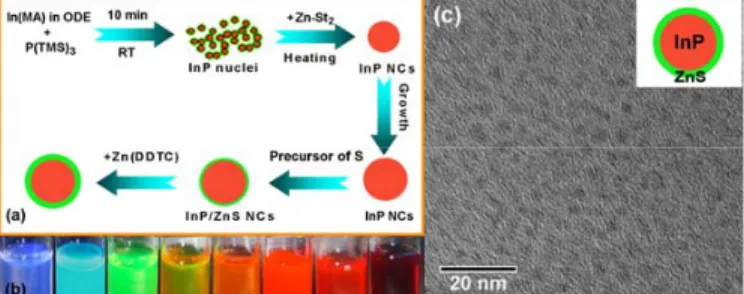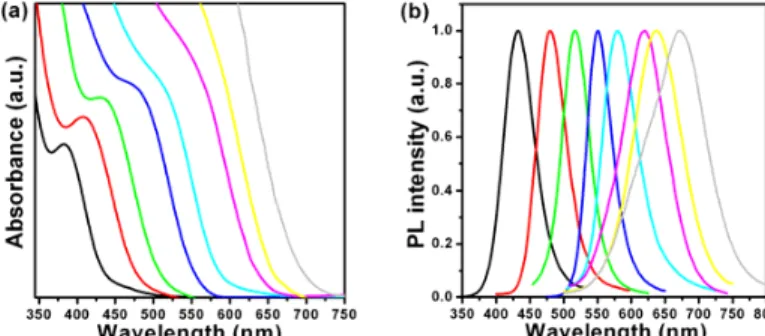High-Quality InP/ZnS Nanocrystals with High Photometric Performance and Their
Application to White Quantum Dot Light-Emitting Diodes
Xuyong Yang,
1Swee Tiam Tan,
1Hilmi Volkan Demir
1,2∗and Xiao Wei Sun
1∗ 1 Luminous! Center of Excellence for Semiconductor Lighting and Displays, School of Electrical and Electronic Engineering, Nanyang Technological UniversityNanyang Avenue, Singapore 639798 (Singapore)
2 Department of Electrical and Electronics Engineering, Department of Physics, UNAM – Institute of Materials Science and Nanotechnology, Bilkent University, Bilkent, Ankara, 06800 (Turkey) E-mail: hvdemir@ntu.edu.sg and EXWSun@ntu.edu.sg
Abstract: Full visible range covering InP/ZnS core-shell nanocrystals with high photometric performance have been prepared. Making use of these nanocrystals, we demonstrate a white quantum dot LED with a high color rendering index of 91.
Keywords: indium phosphide; nanocrystal; solvothermal synthesis; photoluminescence; LED
Semiconductor nanocrystals (NCs), also known as colloidal quantum dots (QDs) - efficient, spectrally pure emitters that can be optically or electrically excited - have emerged as a competitive choice for the emissive component of light-emitting devices (LEDs).1-3 The electronic structure of NCs, which typically range from 3 to 12 nm in diameter, is dominated by quantum size effects. This gives colloidal NCs their signature narrow band emission that results in saturated color emission and can be spectrally positioned by controlling the nanocrystal size during synthesis. Currently, CdSe NCs as the workhorse have been well developed for such uses.4 Despite their apparent advantages, the intrinsic toxicity of CdSe NCs makes them environmentally restricted, which has thus cast a doubtful future for their practical applications5. Indium phosphide (band gap: 1.35 eV) is considered as the ideal alternative material, which offers a similar emission wavelength range but without intrinsic toxicity.6-8 However, there exist crucial problems related to the performance of these InP NCs. Among them are their color purity and emission spectrum tunability, which are much inferior to the well-developed CdSe NCs. The inferior properties of InP NCs originate from a harsh reaction control owing to the strong coordinating strength of indium ligands. The emission linewidth of the typical InP NCs reported is wider (50 - 80 nm) than that of CdSe (15 - 40 nm), which leads to a worse color purity for InP as compared to CdSe. In this paper, we report on the controlled synthesis of high-quality InP/ZnS core-shell NCs by a facile one-pot solvothermal method. The resulting NCs show high quantum yields (above 60%), wide range spectrum tunability, narrow emission linewidths, and excellent photostability. The photoluminescence full width at half maxima FWHM of only 38 nm presented in this work is the narrowest linewidth reported for InP-based NCs to date. In addition, utilizing the resulting InP/ZnS NCs, a white QD-LED has been demonstrated with a high color rendering index of 91.
Figure 1. (a) Schematic of the synthetic procedure of InP/ZnS NCs. (b) Photograph of the samples with different ratios of InP:ZnS excited by UV light. (c) TEM image of the resulting InP/ZnS NCs at low magnification. The inset in (c) illustrates the core-shell structure of InP/ZnS NCs. Here the red region represents InP core, and the green part show ZnS shell.
Firstly, the high-quality InP/ZnS NCs with photometric performance are successfully developed. For a typical synthesis of InP/ZnS core-shell NCs, indium myristate (In(MA)), tris(trimethylsilyl)phosphine (P(TMS)3), and octadecene (ODE) were mixed in glove box firstly. Next, the as-prepared InP nucleus solution was transferred into a three-neck flask, and then zinc stearate (Zn-St2) was added into the reaction system. The mixture was heated to 300 °C and kept for a certain time to grow InP cores with Zn-rich surface. Subsequently, the precursor of S was injected into InP core-containing solution for growing ZnS shell. After that, an additional ZnS shell can also be obtained by the decomposition of zinc
- 1 -
758
ThH4 (Contributed Oral)
9:30 AM – 9:45 AM
diethyldithiocarbamate. The process is illustrated in Figure 1a. The image of these NC samples with different ratios of InP:ZnS excited by UV light is shown in Figure 1b. The confirmation of a narrow size distribution can be directly observed by using a transmission electron microscope (TEM) (Figure 1c).
Figure 2.UV-Vis absorption and PL spectra of the resulting InP/ZnS NCs with different ratios of InP:ZnS (increasing the ratio of InP to ZnS from left to right). The PL and absorption spectra of NCs were red-shifted successively.
Next, we characterize the optical properties of the resulting NCs. The absorption spectra and photoluminescence (PL) emission wavelength can be continuously tuned from blue to near-infrared region by increasing the ratio of InP precursors to zinc stearate. For these resulting nanocrystals, the maximum QY of 60.2 % can be obtained. Meanwhile, these nanocrystals exhibit narrow emission linewidth (can be as narrow as 38 nm) and excellent photostability, which is comparable to that of CdSe NCs. The effective passivation of the surface-state traps of the NC cores in terms of the strain-relieved shells is considered as the origin of the observed high photometric performance.
Figure 3. (a) Energy band diagram of the QD-LEDs using InP/ZnS QDs. The theoretical values for the HOMO and LUMO for individual layer. (b) PL spectrum of red-emitting InP/ZnS NCs and EL spectrum of white QD-LEDs. (c) CIE chromaticity coordinate diagram of the white QD-LEDs and a photograph of a QD-LED with a pixel size of 3 mm×3 mm (inset).
To assess suitability of the resulting InP/ZnS core-shell NCs as emitters for QD-LED application, a device structure of ITO/PEDOT:PSS/poly-TPD/QDs/TPBi/LiF/Al was fabricated, for which the corresponding schematic energy level diagram is shown in Figure 3a. The LED output spectrum is recorded at the bias voltage of 11 V (Figure 3b), exhibiting a broadband coverage over the entire visible wavelength regime. The red emission is attributed to the red-emitting InP/ZnS NCs, which is spectrally complementary to the blue-green emission of poly-TPD for white light generation. The CIE coordinates of the cadmium-free LED is (0.332, 0.338), which is close to the balanced white coordinates (inset of Figure 3c). In addition, the white light of the QD-LED is characterized with a high CRI of 91, significantly higher than that of most of solid-state white LEDs. An image of the white QD-LED output was recorded at a luminance of 270 cd/m2 (inset of Figure 6c), which displays bright and uniform white emission.
Therefore, it can be concluded that the high performance of the InP/ZnS core-shell nanocrystals coupled with their low intrinsic toxicity may promote industrial applications of nanocrystal emitters.
References
[1] X. Yang, D. Zhao, K. S. Leck, S. T. Tan, Y. X. Tang, J. Zhao, H. V. Demir, X. W. Sun, Adv. Mater. 2012, DOI: 10.1002/adma.201104990.
[2] H. V. Demir, S. Nizamoglu, T. Erdem, E. Mutlugun, N. Gaponikc, A. Eychmüller, Nano Today 2011 6, 632–647. [3] L. Qian, Y. Zheng, J. Xue, P. H. Holloway, Nature Photon. 2011, 5, 543–548.
[4] T. Nann, W. M. Skinner, ACS Nano 2011, 5, 5291–5295. [5] T. Erdem, H. V. Demir, Nat. Photon. 2011, 5, 126.
[6] P. M. Allen, B. J. Walker, M. G. Bawendi, Angew. Chem. 2010, 122, 772 –774.
[7] S. Kim, J. Park, T. Kim, E. Jang, S. Jun, H. Jang, B. Kim, S. W. Kim, Small 2011, 7, 70–73. [8] S. Tamang, G. Beaune, I. Texier, P. Reiss, ACS Nano 2011, 5, 9392–9402.

